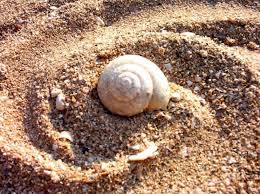In contemporary life, we respect failure only if we can interpret it as a stepping-stone to accomplishment. But this makes us miss failure’s special beauty.
If ever you doubt that nature loves futility and failure, go to the sea. Walking in the surf last month in South Africa, I saw a plethora of little blue snails burrowing into the sand. The precision and the effort they put into it was amazing: first the pinprick of a hole in the beach, then a wriggle until only the round ends of their shells peeked out. They looked snug, at home.
And then, of course, the wave: it demolished all their effort, sending them tumbling back and leaving them squirming, slimy foot upturned, in the receding surf. Repeat. Every effort they made was repulsed, and still they turned themselves over and persisted in rooting into the sand.
I wondered if their efforts had some hidden purpose. I asked a pair of marine biologists: Hunger, they suggested, or the drive for shelter. But whatever their goal, the fact remained that they were overturned over and over, and tried again and again, in a perfect cycle of failure and desire.
It was a reminder that Nature doesn’t operate according to the four-hour workweek, the laws of maximum efficiency and effectiveness, whereby every misstep and wrong choice is a source of shame. On the contrary: mistakes combat stasis; missteps yield evolution; a thousand seeds drift in the wind that never take root, and those that take root crumple again in the hurricane.
In contemporary life, we respect failure only if we can interpret it as a stepping-stone to accomplishment. This is the premise of a raft of recent books, from “Failing Forward” to “The Upside of Down: Why Failing Well Is the Key to Success”. A week ago, a group of young writers asked me what my favorite writing achievement was; I proudly told the story of an essay that was at first rejected by a favorite magazine and then, after much work and rewriting, accepted at another. The tale, presented as a celebration of the necessity of making mistakes, was in fact a sly way of revealing not my fallibility but my tenacity. My reaction to initial failure, I was claiming, is what makes me not fail in the long run.
The real truth, though, is that most of our mistakes cannot really be said to have such obvious redemptive power. Most of the time, we simply lose time. We retrace our steps. We let friends fall away; we hurt our families. We do idiotic things in our work. We make mistakes from which we learn and, more often, mistakes from which we fail to learn. Aware of our errors, but frequently unable to do better, we hang our heads.
The writer Kathryn Schulz has suggested that acknowledging the distinctive essence of failure rather than straining to invest it with positive utility actually allows us to experience a greater range of emotions and see more texture and color in the world.
Just as understanding the night as merely a period that gives birth to day would cause us to miss so much of its particular charm, so seeing failure only as an element of success causes us to dismiss at least half of the human experience.
Failure, she says, can feed imagination, as we construct ideas of what might have happened if we hadn’t made mistakes. It gives rise to black humor. It can make us less arrogant, more empathetic.
I think failure has a special beauty to it. Like a piece of furniture that falls apart, a mistake reveals more of its construction — of the efforts and motivations of the mistake-maker — than a success does. Paradoxically, it can thus provide a source of inspiration to others. How moving was theviral video of the Kenyan marathoner who lost a race because she ran too hard at the beginning but so yearned to cross the finish line she nearly died trying? Or the early aviators who crashed for the sake of a dream?
In my walk on the South African shore, further up on the sand and out of the surf, I found the paw-prints of a tiny dog. Deep holes at the front of the prints showed it had its claws out, trying to gain a purchase on the friable earth. Clearly, it was failing. Slid-marks revealed where it stumbled, and a few body prints where it fell.
And I smiled: the thought of the struggling dog was at once sad and lovely. I imagined it so eager to run it just persisted in trying, despite the evidence it wasn’t possible, like the snails persisted burrowing in the sand. And its sheer desire, uncoupled from any outcome or achievement, was something wonderful.



